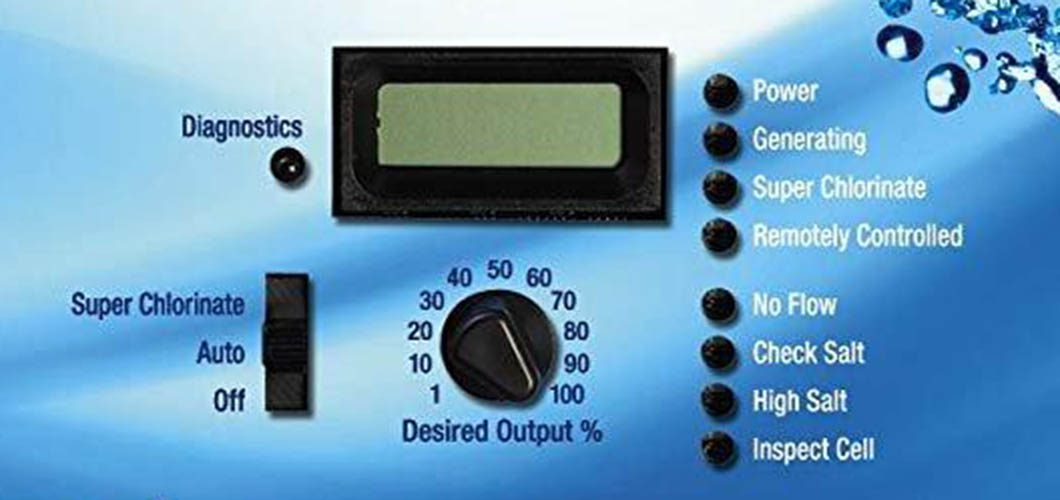Hayward Salt Cell Troubleshooting: Expert Tips & Solutions
Are you struggling with your Hayward salt cell and wondering what’s going wrong? You’re not alone.
Many pool owners face challenges with their salt systems, often unsure how to troubleshoot effectively. Imagine the relief of diving into crystal-clear water without a worry in the world. This article is here to guide you through common issues with Hayward salt cells, helping you take control and get your pool back to its sparkling best.
Whether it’s a persistent error code or a surprising drop in chlorine levels, we’ll explore solutions that are simple and actionable. Stay with us, and transform your pool maintenance from a daunting task into a straightforward routine. Let’s dive in and uncover how you can keep your pool pristine and your summer stress-free!

Credit: lesliespool.com
Common Issues With Hayward Salt Cells
Hayward salt cells help maintain a clean and safe swimming pool. Yet, they can face issues that affect performance. Understanding these problems helps ensure smooth operation. Let’s explore common issues that occur with Hayward salt cells.
Low Chlorine Production
Low chlorine levels can lead to algae growth and cloudy water. A dirty cell often causes this issue. Check for calcium buildup or debris on the cell plates. Inspect the salt level in the pool. It should match the recommended range. Ensure the flow rate is adequate. The pool pump may need adjustment.
Cell Cleaning Indicators
Hayward salt cells have cleaning indicators. These signals alert users about necessary maintenance. A buildup of calcium or minerals triggers these indicators. Regular cleaning of the cell plates is essential. This process prevents damage and maintains efficiency.
Error Codes And Their Meanings
Error codes appear on the display panel. Each code indicates a specific problem. For example, “Check Salt” means low salt levels. “High Salt” signals excessive salt in the pool. “Check Cell” suggests the cell needs inspection or cleaning. Understanding these codes helps in quick troubleshooting.

Credit: diy.inyopools.com
Diagnosing Salt Cell Problems
Diagnosing salt cell problems can feel like navigating through a labyrinth, especially when your pool maintenance schedule gets disrupted. Is your pool water looking murky, or is the chlorine level unexpectedly low? These might be signs of a malfunctioning salt cell. Let’s dive into some practical techniques to diagnose these issues, ensuring you enjoy a crystal-clear pool all season long.
Visual Inspection Techniques
A simple glance can reveal a lot. Start by examining the salt cell closely for any visible damage or wear. Look for signs of corrosion, cracks, or mineral build-up. These issues can hinder the cell’s performance. Remember the time you found a crusty layer on your cell, which was silently sabotaging your pool’s cleanliness? Scrubbing off such deposits can sometimes restore its efficiency.
Testing Salt Levels
Accurate salt levels are crucial for your salt cell to function correctly. Use a salt meter or test strips to measure the salt concentration in your pool. If the levels are off, it could be why your chlorine generator isn’t working properly. Once, I discovered my pool was too salty – a simple adjustment fixed the chlorine production. Keep an eye on these levels regularly to prevent such mishaps.
Electrical Connection Checks
The salt cell relies on electrical connections to operate effectively. Inspect the connections for any loose wires or corrosion. A secure connection is essential for the cell to function. Remember, a minor loose wire once left my pool without chlorine for days. Ensure everything is tightly connected and free from rust to avoid unnecessary complications.
Have you tried these methods before? What unexpected challenges did you encounter while diagnosing your salt cell problems? Share your story below and let’s keep the pool conversation flowing!
Effective Cleaning Methods
Maintaining the performance of your Hayward salt cell requires effective cleaning methods. Proper cleaning ensures the longevity and efficiency of the salt cell. Regular cleaning prevents common issues like calcium build-up, which can hinder its functionality. Let’s explore some tried and tested cleaning techniques that can help.
Vinegar Cleaning Process
Vinegar is a natural and safe cleaning agent. It effectively dissolves mineral deposits from your salt cell. Begin by disconnecting the salt cell from the system. Soak the cell in a container filled with vinegar for several hours. This process helps break down any calcium deposits. Once soaked, rinse the cell with fresh water. Make sure to remove all vinegar traces. Reconnect the cell and check its performance. This simple method keeps your salt cell clean and efficient.
Using A Mild Acid Solution
A mild acid solution offers another cleaning option. You can use diluted muriatic acid for this process. Mix one part acid with ten parts water. Wear protective gear to ensure safety. Carefully pour the solution into the cell. Let it sit for a few minutes. This solution dissolves stubborn deposits effectively. Rinse the cell thoroughly after cleaning. Ensure no acid residue remains. This method helps maintain optimal cell function.
Routine Maintenance Tips
Regular maintenance extends your salt cell’s life. Inspect your salt cell every few months. Check for any visible deposits or damage. Clean the cell using either vinegar or mild acid solutions. Keep the cell’s surroundings clean and dry. Ensure proper water flow around the cell. Monitor the cell’s performance regularly. Replace the cell if issues persist despite cleaning. These routine steps help prevent costly repairs and ensure smooth operation.

Credit: www.inyopools.com
Replacement And Repairs
Maintaining a Hayward salt cell ensures your pool water stays clean. Over time, these cells can wear out or need repairs. Knowing when to repair or replace can save time and money. This guide provides useful tips on managing your salt cell issues.
When To Replace The Salt Cell
Salt cells have a typical lifespan of three to five years. If your pool water looks cloudy, it may signal the cell’s end. Reduced chlorine levels also indicate a failing cell. Check for scale buildup on the cell plates. Excessive buildup often means replacement is necessary. Frequent service lights on your control box can also suggest it’s time for a new cell.
Diy Repair Tips
Inspect the cell regularly for any visible damage. Cleaning the cell can resolve some issues. Use a mixture of water and acid to remove scale buildup. Ensure connections are secure and free from corrosion. If the cell does not produce chlorine, check the power supply. Reset the control box to see if the issue resolves.
Choosing The Right Replacement
Choose a replacement cell that matches your existing system. Ensure it fits your pool’s size and capacity. Compatibility with your control box is crucial. Read reviews to find a reliable brand. Consider the warranty options for added peace of mind. Investing in a quality cell ensures better performance and longevity.
Preventive Measures
Keeping your Hayward salt cell in top condition is crucial for a stress-free pool season. By taking preventive measures, you can avoid unexpected breakdowns and costly repairs. Let’s dive into some simple strategies that can save you time and money.
Regular Maintenance Schedule
Creating a regular maintenance schedule is the backbone of preventing salt cell issues. Just like you wouldn’t skip a doctor’s appointment, don’t neglect your pool equipment. Set a monthly reminder to check your salt cell for debris, scale, or any visible damage. Cleaning the cell with a diluted acid solution can prevent scale buildup. This proactive approach keeps your salt cell functioning efficiently.
Optimal Salt Levels
Maintaining optimal salt levels is crucial for your salt cell’s health. Check your pool’s salt concentration regularly using a test kit or digital meter. The ideal range is typically between 2700-3400 ppm. Adjusting your salt levels ensures the cell can generate chlorine effectively. Over or under-salting can lead to premature cell failure or subpar performance.
Avoiding Common Mistakes
Many pool owners unknowingly make mistakes that shorten their salt cell’s lifespan. Avoid placing pool chemicals directly into the skimmer, as this can damage the cell. Be mindful of power surges; using a surge protector can shield your equipment. Have you ever thought about the impact of incorrect winterizing? Properly winterizing your pool can prevent freeze damage to the salt cell.
What steps are you taking to ensure your salt cell remains in peak condition? Remember, a little attention now can prevent bigger headaches later. Implement these preventive measures and enjoy a hassle-free swimming experience.
Professional Assistance
Struggling with your Hayward salt cell? Professional assistance ensures smooth troubleshooting. Experts can quickly identify and fix issues. Enjoy a stress-free pool experience.
When tackling issues with your Hayward salt cell, you might reach a point where DIY solutions just aren’t cutting it. That’s when professional assistance can be a game-changer. Knowing when to call in the pros can save you time, stress, and potentially prevent more costly repairs down the line. Here’s how to navigate the waters of professional help effectively.When To Call An Expert
There are specific signals that indicate it’s time to bring in a professional. If you’ve tried troubleshooting on your own, yet the salt cell still isn’t functioning, it might be time for expert eyes. Unexpected error codes that don’t clear with basic resets also warrant a call to a technician. Water quality issues can be another red flag. If your pool water is consistently cloudy or algae-laden despite chemical balance efforts, this might point to a deeper issue with the salt cell. Trust your instincts; if something feels off and you’re unsure, reaching out for help is wise.Finding A Qualified Technician
Start by seeking recommendations from friends or neighbors who own pools. Their experiences can guide you to reliable professionals. Online reviews and ratings are also valuable resources to assess the reputability of technicians in your area. When contacting a potential technician, ask about their experience specifically with Hayward salt cells. This specialization can make a significant difference in the quality of service you receive. Don’t hesitate to ask for certifications or training they’ve completed, ensuring they meet industry standards.Cost Considerations
Understanding the cost involved in hiring a professional is crucial. Request an estimate before any work begins to prevent surprises on your bill. Many technicians offer free initial consultations or diagnostic visits, which can help you gauge the problem without immediate financial commitment. Consider the long-term savings of professional repairs. While DIY fixes may seem cost-effective initially, improper handling can lead to more expensive issues. Investing in expert assistance could ultimately be the more economical choice in maintaining your pool’s health. Think about the value of your time and peace of mind. How much is it worth to you to have your pool running smoothly without the hassle of constant troubleshooting? Professional help might just be the answer you need.Frequently Asked Questions
Why Is My Hayward Salt Cell Not Producing Chlorine?
Your salt cell might be dirty or old. Clean it. Check the power supply. Replace if necessary.
How Do I Reset My Hayward Salt Cell?
Reset by turning off the power. Wait a few minutes. Turn it back on.
What Causes A Hayward Salt Cell To Fail?
Common causes include calcium buildup, old age, or a broken power unit. Regular maintenance helps.
How Often Should I Clean My Salt Cell?
Clean every three months. More often if you have hard water. Prevents buildup.
Can Low Salt Levels Damage My Hayward Salt Cell?
Yes, low salt can cause damage. Check and adjust salt levels regularly. Ensure proper function.
Conclusion
Troubleshooting a Hayward salt cell can seem tricky at first. But with patience, you can solve many issues yourself. Regular maintenance helps keep your system running smoothly. Check connections, inspect the cell, and test the water regularly. These steps save time and frustration.
Remember, keeping your pool clean and balanced is important. Seek help if problems persist. A professional can provide expert advice when needed. Stay informed and enjoy a trouble-free swimming season. Happy swimming!





